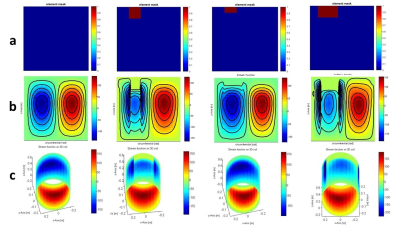1761
Analysis of the target gradient method for asymmetric gradient coils1Medical Imaging Research Center, Dayananda Sagar Institution, Bangalore, India, 2Dept.of Radiology,Medical Physics, University of Freiburg, Medical Center, Freiburg, Germany, 3Dept.of Radiology, Columbia University Medical Center, NewYork, NY, United States
Synopsis
Gradient coils are traditionally designed using variations of the target field method. For asymmetric
Introduction
Gradient coil design is traditionally accomplished using a variety of
current target field methods (TFM) [1,2], whereby the z-component of the
desired encoding field Bz within a target region of interest is
specified and a current density on the coil’s current carrying surface
is sought using an optimization method of choice. Typically the current
carrying surface is represented by a cylinder centered about a spherical
or elliptical target region. The current density is typically
represented by a stream function, which can easily be converted to a
winding pattern by plotting its level lines. A variation of the target
field method may easily be derived, which specifies the components of
the gradient of Bz in the target region instead of the Bz itself. This
has an advantage of a more direct control of the local deviations of the
gradient strength, which is of a great relevance for imaging
applications. A further advantage of the gradient-based method that it
is capable of choosing an optimal center field offset for coils with a
non-symmetric or irregular current carrying surfaces. In this study, we
evaluate the performance of the target gradient method (TGM) and compare
it to TFM on an example of an unshielded head gradient insert with a
window in the face region.Methods
Results and Discussion
Figure 1 shows the peak current in the coil designs generated by both TGM and TFM, normalized to the symmetric TGM design. As seen, the proximity of the center of the target volume to the coil end readily presents a problem for Gz for a design without a window resulting in a 2.5 and 3 fold increase for the TGM and TFM designs, respectively. Both Gy and Gz are affected by the window, whereas window width presents a larger challenge for Gz, and window height for Gy, respectively, whereas TGM shows a consistently better performance. Figure 2 presents similar data for the power dissipated by the coil and is characterized by similar trends. Figure 3 displays the ratio between the power dissipated by TFM to that of TGM designs. As seen, TGM shows a consistently good performance and appears to be particularly advantageous for Gz. Figure 4 shows examples of different window size along with its stream functions.
In this study, we did not consider force- and torque-balance explicitly, which may be an issue for non-symmetric coils, but it is expected that upon introduction of these constraints TGM will preserve its advantages. Further research is needed to verify the performance of TGM for shielded gradient designs.
Conclusions
Acknowledgements
This work was supported, in part, by the ISMRM Research Exchange Program.References
[1] Lemdiasov RA, Ludwig R. A stream function method for gradient coil design. Concepts Magn. Reson. Part B: Magn. Reson. Eng. 2005 26B:67-80.
[2] Poole M, Bowtell R. Novel gradient coils designed using a boundary element Method. Concepts Magn. Reson. Part B: Magn. Reson. Eng. 2007 31B:162-75.
[3] Littin S, Gallichan D, Welz AM, Jia F, Dewdney A, Weber H, Schultz G, Hennig J, Zaitsev M. Monoplanar gradient system for imaging with nonlinear gradients. MAGMA. 2015 28:447-57.
Figures



